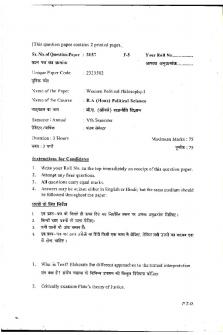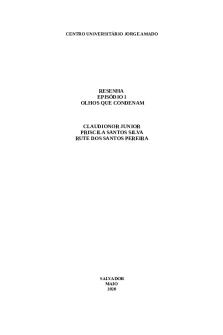Lab 10 AP CPP - Lab 10 AP CPP PDF

| Title | Lab 10 AP CPP - Lab 10 AP CPP |
|---|---|
| Author | yash gandhi |
| Course | Data Warehousing And Data Mining |
| Institution | Delhi Technological University |
| Pages | 6 |
| File Size | 403.5 KB |
| File Type | |
| Total Downloads | 65 |
| Total Views | 142 |
Summary
Lab 10 AP CPP...
Description
Program – 10 AIM: To Implement Apriori algorithm in C++ Introduction and Theory Association rules are if-then statements that help to show the probability of relationships between data items within large data sets in various types of databases. Association rule mining has a number of applications and is widely used to help discover sales correlations in transactional data or in medical data sets. Association rule mining, at a basic level, involves the use of machine learning models to analyze data for patterns, or co-occurrence, in a database. It identifies frequent if-then associations, which are called association rules. An association rule has two parts: an antecedent (if) and a consequent (then). An antecedent is an item found within the data. A consequent is an item found in combination with the antecedent. Association rules are created by searching data for frequent if-then patterns and using the criteria support and confidence to identify the most important relationships. Support is an indication of how frequently the items appear in the data. Confidence indicates the number of times the if-then statements are found true. A third metric, called lift, can be used to compare confidence with expected confidence. Association rules are calculated from itemsets, which are made up of two or more items. If rules are built from analyzing all the possible itemsets, there could be so many rules that the rules hold little meaning. With that, association rules are typically created from rules wellrepresented in data. Measure 1: Support. This says how popular an itemset is, as measured by the proportion of transactions in which an itemset appears. The support of an itemset X, supp(X) is the proportion of transaction in the database in which the item X appears. It signifies the popularity of an itemset. supp(X)=Number of transaction in which X appears/Total number of transactions. If the sales of a particular product (item) above a certain proportion have a meaningful effect on profits, that proportion can be considered as the support threshold. Furthermore, we can identify itemsets that have support values beyond this threshold as significant itemsets. Measure 2: Confidence. This says how likely item Y is purchased when item X is purchased, expressed as {X -> Y}. This is measured by the proportion of transactions with item X, in which item Y also appears. Confidence of a rule is defined as follows: 𝑠𝑢𝑝𝑝(𝑋 ∪ 𝑌) 𝑐𝑜𝑛𝑓(𝑋 ⟶ 𝑌) = 𝑠𝑢𝑝𝑝(𝑋) It signifies the likelihood of item Y being purchased when item X is purchased.
1|Page
Program – 10 This implies that for 75% of the transactions containing onion and potatoes, the rule is correct. It can also be interpreted as the conditional probability P(Y|X), i.e, the probability of finding the itemset Yin transactions given the transaction already contains X. It can give some important insights, but it also has a major drawback. It only takes into account the popularity of the itemset X and not the popularity of Y. If Y is equally popular as X then there will be a higher probability that a transaction containing X will also contain Y thus increasing the confidence. To overcome this drawback there is another measure called lift. Measure 3: Lift. This says how likely item Y is purchased when item X is purchased, while controlling for how popular item Y is. A lift value greater than 1 means that item Y is likely to be bought if item X is bought, while a value less than 1 means that item Y is unlikely to be bought if item X is bought. The lift of a rule is defined as: 𝑠𝑢𝑝𝑝(𝑋 ∪ 𝑌) 𝑙𝑖𝑓𝑡(𝑋 ⟶ 𝑌) = 𝑠𝑢𝑝𝑝(𝑋) ∗ 𝑠𝑢𝑝𝑝(𝑌) This signifies the likelihood of the itemset Y being purchased when item X is purchased while taking into account the popularity of Y. If the value of lift is greater than 1, it means that the itemset Y is likely to be bought with itemset X, while a value less than 1 implies that itemset Y is unlikely to be bought if the itemset X is bought.
Applications: Market Basket Analysis: This is the most typical example of association mining. Data is collected using barcode scanners in most supermarkets. This database, known as the “market basket” database, consists of a large number of records on past transactions. A single record lists all the items bought by a customer in one sale. Knowing which groups are inclined towards which set of items gives these shops the freedom to adjust the store layout and the store catalogue to place the optimally concerning one another. Medical Diagnosis: Association rules in medical diagnosis can be useful for assisting physicians for curing patients. Diagnosis is not an easy process and has a scope of errors which may result in 2|Page
Program – 10 unreliable end-results. Using relational association rule mining, we can identify the probability of the occurrence of an illness concerning various factors and symptoms. Further, using learning techniques, this interface can be extended by adding new symptoms and defining relationships between the new signs and the corresponding diseases. Census Data: Every government has tonnes of census data. This data can be used to plan efficient public services(education, health, transport) as well as help public businesses (for setting up new factories, shopping malls, and even marketing particular products). This application of association rule mining and data mining has immense potential in supporting sound public policy and bringing forth an efficient functioning of a democratic society. Protein Sequence: Proteins are sequences made up of twenty types of amino acids. Each protein bears a unique 3D structure which depends on the sequence of these amino acids. A slight change in the sequence can cause a change in structure which might change the functioning of the protein. This dependency of the protein functioning on its amino acid sequence has been a subject of great research. Earlier it was thought that these sequences are random, but now it’s believed that they aren’t. Knowledge and understanding of these association rules will come in extremely helpful during the synthesis of artificial proteins.
Code 1 2 3 4 5 6 7 8 9 10 11 12 13 14 15 16 17 18 19 20 21 22 23 24 25 26 27 28 29
#include #include using namespace std; ifstream fin; double minfre; vector datatable; set products; map freq; vector wordsof(string str) { vector tmpset; string tmp = ""; int i = 0; while (str[i]) { if (isalnum(str[i])) tmp += str[i]; else { if (tmp.size() > 0) tmpset.push_back(tmp); tmp = ""; } i++; } if (tmp.size() > 0) tmpset.push_back(tmp);
3|Page
Program – 10 30 31 32 33 34 35 36 37 38 39 40 41 42 43 44 45 46 47 48 49 50 51 52 53 54 55 56 57 58 59 60 61 62 63 64 65 66 67 68 69 70 71 72 73 74 75 76 77 78 79 80 81 82 83 84 85 86
return tmpset; } string combine(vector &arr, int miss) { string str; for (int i = 0; i < arr.size(); i++) if (i != miss) str += arr[i] + " "; str = str.substr(0, str.size() - 1); return str; } set cloneit(set &arr) { set dup; for (set::iterator it = arr.begin(); it != arr.end(); it++) dup.insert(*it); return dup; } set apriori_gen(set &sets, int k) { set set2; for (set::iterator it1 = sets.begin(); it1 != sets.end(); it1++) { set::iterator it2 = it1; it2++; for (; it2 != sets.end(); it2++) { vector v1 = wordsof(*it1); vector v2 = wordsof(*it2); bool alleq = true; for (int i = 0; i < k - 1 && alleq; i++) if (v1[i] != v2[i]) alleq = false; if (!alleq) continue; v1.push_back(v2[k - 1]); if (v1[v1.size() - 1] < v1[v1.size() - 2]) swap(v1[v1.size() - 1], v1[v1.size() - 2]); for (int i = 0; i < v1.size() && alleq; i++) { string tmp = combine(v1, i); if (sets.find(tmp) == sets.end()) alleq = false; } if (alleq) set2.insert(combine(v1, -1)); } } return set2; }
4|Page
Program – 10 87 88 89 90 91 92 93 94 95 96 97 98 99 100 101 102 103 104 105 106 107 108 109 110 111 112 113 114 115 116 117 118 119 120 121 122 123 124 125 126 127 128 129 130 131 132 133 134 135 136 137 138 139 140 141 142 143
int main() { fin.open("apriori.in"); cout > minfre; string str; while (!fin.eof()) { getline(fin, str); vector arr = wordsof(str); //taking data from file , set tmpset; for (int i = 0; i < arr.size(); i++) tmpset.insert(arr[i]); datatable.push_back(tmpset); for (set::iterator it = tmpset.begin(); it != tmpset.end(); it++) { products.insert(*it); freq[*it]++; } } fin.close(); cout...
Similar Free PDFs

Lab 10 AP CPP - Lab 10 AP CPP
- 6 Pages

CPP
- 2 Pages

Lab 10 - Lab 10
- 17 Pages

AP Chem Lab - Hydrate Lab
- 3 Pages

Lab 01 Meraki AP - lab
- 5 Pages

Lab 10 - Lab 10 Report
- 7 Pages

GEOG Lab 10 - lab 10
- 4 Pages

AP Bio Photosynthesis Lab
- 1 Pages

AP Bio Transpiration Lab
- 24 Pages

ap lab homework
- 5 Pages

AP 5069 L13 Respiratory LAB AP
- 9 Pages

Olhos QUE Condenam CPP
- 11 Pages

Lab 10 - PH111 LAB
- 2 Pages

AP Psych CH 10 Notes
- 11 Pages

Lab 10
- 14 Pages
Popular Institutions
- Tinajero National High School - Annex
- Politeknik Caltex Riau
- Yokohama City University
- SGT University
- University of Al-Qadisiyah
- Divine Word College of Vigan
- Techniek College Rotterdam
- Universidade de Santiago
- Universiti Teknologi MARA Cawangan Johor Kampus Pasir Gudang
- Poltekkes Kemenkes Yogyakarta
- Baguio City National High School
- Colegio san marcos
- preparatoria uno
- Centro de Bachillerato Tecnológico Industrial y de Servicios No. 107
- Dalian Maritime University
- Quang Trung Secondary School
- Colegio Tecnológico en Informática
- Corporación Regional de Educación Superior
- Grupo CEDVA
- Dar Al Uloom University
- Centro de Estudios Preuniversitarios de la Universidad Nacional de Ingeniería
- 上智大学
- Aakash International School, Nuna Majara
- San Felipe Neri Catholic School
- Kang Chiao International School - New Taipei City
- Misamis Occidental National High School
- Institución Educativa Escuela Normal Juan Ladrilleros
- Kolehiyo ng Pantukan
- Batanes State College
- Instituto Continental
- Sekolah Menengah Kejuruan Kesehatan Kaltara (Tarakan)
- Colegio de La Inmaculada Concepcion - Cebu
